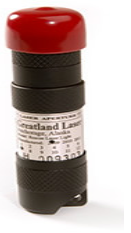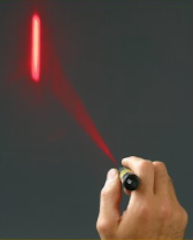Home
A comprehensive resource for safe and responsible laser use

Emergency signaling lasers
Generally, it is illegal in the United States to aim a laser beam at an aircraft. One of the few exceptions makes it legal to aim a “laser emergency signaling device to send an emergency distress signal” (U.S.C. Title 18, Chapter 2, Sec. 39A(c)(3)).


The Greatland “laser flare” shown above at left expands a thin laser beam into a line of light. This allows it to cover a greater area and it also reduces the overall brightness (irradiance), which helps reduce vision-blocking glare when the laser passes over the pilot or driver of a search-and-rescue vehicle. According to a seller of the laser flare, its irradiance is 1,000 times less than a laser pointer, yet it can still call attention to rescuers. The red model above is claimed to have a 20 mile range at nighttime and a 1-3 mile range in the day. A green version has a 30 mile range at nighttime and a 3-5 mile range in the day.
The seller also notes that the laser flare was not subject to Australia’s ban on importation of laser pointers, because it is not a pointer under that country’s laws.
Laser flares for boaters
A 2014 review in Cruising World also pointed out another use for laser flares: “They are also excellent at illuminating the reflective tape used on life jackets and vests, ring buoys, survival suits and navigation aids. When the fan of laser light is slowly moved horizontally across an area, any reflective tape on an object that the beam crosses will illuminate with a brilliant burst of light. The red laser works well, but the green laser is by far the best light source we’ve tried.” A green laser flare could pick out a floating life jacket with reflective tape at a distance of 4000 feet.
While the review chose LED-based omnidirectional locator signals as best all around for boaters, Cruising World’s testing concluded that a green laser flare “is “our choice to attract attention and to guide a rescuer to where the omnidirectional LED signal could easily be seen.”
According to the 2014 article, the U.S. Coast Guard is testing electronic signaling devices as replacements for pyrotechnic flares. “They are a great alternative to the short burn time and other problems encountered using pyrotechnics, and ultimately a superior and safe choice for cruisers. Coast Guard testing is in its final stages, and agency officials hope to have signal characteristics finalized soon. This work may lead to changes to domestic regulations that will embrace the use of electronic devices over the next two years.”
Laser pointer for divers
The website for an underwater laser pointer says that it can be used to signal other divers in case of trouble, and of course can be used out of the water to attract attention. Note that this device is not a laser flare and thus may not qualify as a “laser emergency signaling device” — it is merely a laser pointer which is waterproof to 400 feet. (In an emergency, however, a laser pointer may be the best or only device available that can signal to far-away rescuers.)
LaserPointerSafety.com has not researched the topic of laser flares, beyond presenting this one manufacturer’s product. A web search will probably uncover a number of other products, manufacturers, distributors and sellers.
Laser designators
A laser designator expands a laser’s beam to be much wider, like a flashlight. Some laser designators are sold for search and rescue purposes. One manufacturer, Laser Genetics, has a web page discussing its use in search and rescue.